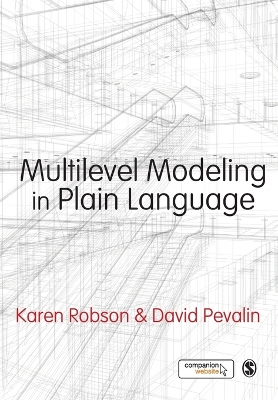Multilevel Modeling in Plain Language
 -15%
portes grátis
-15%
portes grátis
Multilevel Modeling in Plain Language
Pevalin, David; Robson, Karen
Sage Publications Ltd
11/2015
160
Dura
Inglês
9780857029157
15 a 20 dias
440
Descrição não disponível.
Chapter 1: What Is Multilevel Modeling and Why Should I Use It?
Mixing levels of analysis
Theoretical reasons for multilevel modeling
What are the advantages of using multilevel models?
Statistical reasons for multilevel modeling
Assumptions of OLS
Software
How this book is organized
Chapter 2: Random Intercept Models: When intercepts vary
A review of single-level regression
Nesting structures in our data
Getting starting with random intercept models
What do our findings mean so far?
Changing the grouping to schools
Adding Level 1 explanatory variables
Adding Level 2 explanatory variables
Group mean centring
Interactions
Model fit
What about R-squared?
R-squared?
A further assumption and a short note on random and fixed effects
Chapter 3: Random Coefficient Models: When intercepts and coefficients vary
Getting started with random coefficient models
Trying a different random coefficient
Shrinkage
Fanning in and fanning out
Examining the variances
A dichotomous variable as a random coefficient
More than one random coefficient
A note on parsimony and fitting a model with multiple random coefficients
A model with one random and one fixed coefficient
Adding Level 2 variables
Residual diagnostics
First steps in model-building
Some tasters of further extensions to our basic models
Where to next?
Chapter 4: Communicating Results to a Wider Audience
Creating journal-formatted tables
The fixed part of the model
The importance of the null model
Centring variables
Stata commands to make table-making easier
What do you talk about?
Models with random coefficients
What about graphs?
Cross-level interactions
Parting words
Mixing levels of analysis
Theoretical reasons for multilevel modeling
What are the advantages of using multilevel models?
Statistical reasons for multilevel modeling
Assumptions of OLS
Software
How this book is organized
Chapter 2: Random Intercept Models: When intercepts vary
A review of single-level regression
Nesting structures in our data
Getting starting with random intercept models
What do our findings mean so far?
Changing the grouping to schools
Adding Level 1 explanatory variables
Adding Level 2 explanatory variables
Group mean centring
Interactions
Model fit
What about R-squared?
R-squared?
A further assumption and a short note on random and fixed effects
Chapter 3: Random Coefficient Models: When intercepts and coefficients vary
Getting started with random coefficient models
Trying a different random coefficient
Shrinkage
Fanning in and fanning out
Examining the variances
A dichotomous variable as a random coefficient
More than one random coefficient
A note on parsimony and fitting a model with multiple random coefficients
A model with one random and one fixed coefficient
Adding Level 2 variables
Residual diagnostics
First steps in model-building
Some tasters of further extensions to our basic models
Where to next?
Chapter 4: Communicating Results to a Wider Audience
Creating journal-formatted tables
The fixed part of the model
The importance of the null model
Centring variables
Stata commands to make table-making easier
What do you talk about?
Models with random coefficients
What about graphs?
Cross-level interactions
Parting words
Este título pertence ao(s) assunto(s) indicados(s). Para ver outros títulos clique no assunto desejado.
coefficients;intercepts;quantitative;statistics;STATA;R;SPSS;regression;data
Chapter 1: What Is Multilevel Modeling and Why Should I Use It?
Mixing levels of analysis
Theoretical reasons for multilevel modeling
What are the advantages of using multilevel models?
Statistical reasons for multilevel modeling
Assumptions of OLS
Software
How this book is organized
Chapter 2: Random Intercept Models: When intercepts vary
A review of single-level regression
Nesting structures in our data
Getting starting with random intercept models
What do our findings mean so far?
Changing the grouping to schools
Adding Level 1 explanatory variables
Adding Level 2 explanatory variables
Group mean centring
Interactions
Model fit
What about R-squared?
R-squared?
A further assumption and a short note on random and fixed effects
Chapter 3: Random Coefficient Models: When intercepts and coefficients vary
Getting started with random coefficient models
Trying a different random coefficient
Shrinkage
Fanning in and fanning out
Examining the variances
A dichotomous variable as a random coefficient
More than one random coefficient
A note on parsimony and fitting a model with multiple random coefficients
A model with one random and one fixed coefficient
Adding Level 2 variables
Residual diagnostics
First steps in model-building
Some tasters of further extensions to our basic models
Where to next?
Chapter 4: Communicating Results to a Wider Audience
Creating journal-formatted tables
The fixed part of the model
The importance of the null model
Centring variables
Stata commands to make table-making easier
What do you talk about?
Models with random coefficients
What about graphs?
Cross-level interactions
Parting words
Mixing levels of analysis
Theoretical reasons for multilevel modeling
What are the advantages of using multilevel models?
Statistical reasons for multilevel modeling
Assumptions of OLS
Software
How this book is organized
Chapter 2: Random Intercept Models: When intercepts vary
A review of single-level regression
Nesting structures in our data
Getting starting with random intercept models
What do our findings mean so far?
Changing the grouping to schools
Adding Level 1 explanatory variables
Adding Level 2 explanatory variables
Group mean centring
Interactions
Model fit
What about R-squared?
R-squared?
A further assumption and a short note on random and fixed effects
Chapter 3: Random Coefficient Models: When intercepts and coefficients vary
Getting started with random coefficient models
Trying a different random coefficient
Shrinkage
Fanning in and fanning out
Examining the variances
A dichotomous variable as a random coefficient
More than one random coefficient
A note on parsimony and fitting a model with multiple random coefficients
A model with one random and one fixed coefficient
Adding Level 2 variables
Residual diagnostics
First steps in model-building
Some tasters of further extensions to our basic models
Where to next?
Chapter 4: Communicating Results to a Wider Audience
Creating journal-formatted tables
The fixed part of the model
The importance of the null model
Centring variables
Stata commands to make table-making easier
What do you talk about?
Models with random coefficients
What about graphs?
Cross-level interactions
Parting words
Este título pertence ao(s) assunto(s) indicados(s). Para ver outros títulos clique no assunto desejado.






